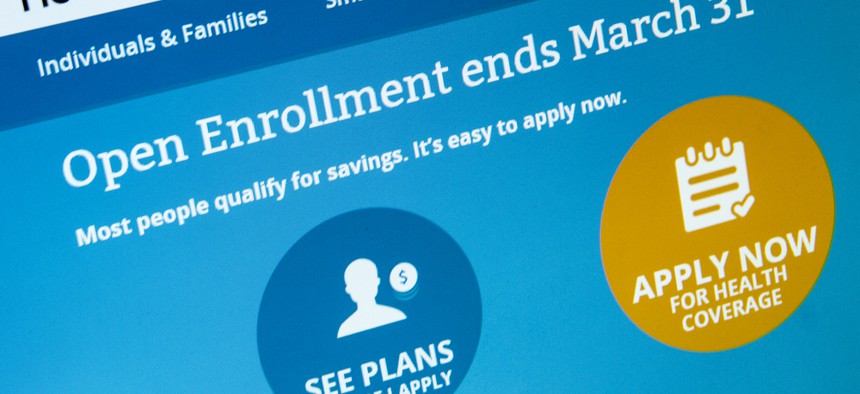
txking / Shutterstock.com
Will Immigration Launch Repeat HealthCare.gov's Mistakes?
The rollout of the Obamacare site was a disaster. The White House wants to make sure that doesn't happen again.
The White House has been down this road before. It knows what happens when lots of people try to sign up for a controversial new government program but can't.
So having been through last year's disastrous rollout of HealthCare.gov, the administration doesn't want history to repeat itself as President Obama's new immigration plan comes to life.
Right now and for the next several months, U.S. Citizenship and Immigration Services employees will be chipping away at creating a process to implement the unilateral immigration plan, called DAPA, that Obama laid out last month. It's one that temporarily protects millions of undocumented immigrants who meet a specific set of criteria from deportation.
To be clear, the process will likely be very different than shopping around an online marketplace for health insurance. But the two initiatives have some fundamental similarities: They're signature Obama programs with high stakes for both the applicant and the administration, and a timely decision hinges on all aspects of the process working smoothly.
"I think that if people just look at it as being caught in the bureaucratic process with no real benefit, why are they going to waste their money?" asked David Leopold, past president of the American Immigration Lawyers Association. "It's really incumbent upon the government to make this work."
The good news, he said, is there's already a template that's been working for more than two years.
In June 2012, Obama stood in the Rose Garden ready to unveil a program he'd been quietly planning—an executive action providing temporary deportation relief to undocumented immigrants who came to the United States before their 16th birthday, among other criteria.
It's called Deferred Action for Childhood Arrivals, or DACA, and for the next 60 days, USCIS officials scrambled to ready the program for its launch date. The agency produced training materials for its newly hired adjudicators. It wrote internal guidelines for USCIS employees and held training sessions. It acquired work space for the new employees, geared up its computer systems, and issued public guidance materials detailing exactly how to apply for DACA, according to Stephen Legomsky, USCIS's chief counsel at the time.
Two months later, the program began taking applicants.
"The DACA implementation was unbelievably smooth and efficient," Legomsky said. "That was not what I would have predicted."
Yet the program has been met with staunch resistance from House Republicans. They've taken a ceremonial vote to end DACA, similar to ones attempting to halt various parts of and the entirety of the Affordable Care Act. But their rallying cries against Obamacare have a different sort of leverage: The GOP can say the administration bumbled the rollout. With DACA, they haven't.
"They really did pull off the seemingly impossible," Leopold said. "The process that was put in place is a decent process that seemed to work."
Some immigration lawyers say nothing about it was like the HealthCare.gov rollout, when frustrated applicants were met with errors when attempting to sign up electronically for health insurance on day one and in the ensuing months.
"[DACA] wasn't even in the neighborhood of the health care implementation issues," said Crystal Williams, AILA executive director, "because nothing was automated; that oddly enough helped. As government programs go and certainly as immigration programs go, it was quite smooth."
Anecdotally, DACA decisions slowed a bit as the program entered its first full year. For some, the wait could last six months or longer, according to Leopold.
Many potential recipients had waited to apply to DACA, wanting to make sure it wasn't a ploy to deport them out of the country. But once neighbors and friends began receiving deportation deferrals without consequences, application numbers increased. About 1.2 million people met DACA's criteria at its launch, and about 55 percent of those had applied as of July 20. More than 585,000 have been accepted, according to the Migration Policy Institute.
The one reported hang-up for DACA didn't apply to the program itself. Processing times slipped for naturalizations and spouses of citizens applying for green cards, according to David Martin, a former Department of Homeland Security principal deputy general counsel who left before the DACA program began. He said the delay can partially be attributed to diverting the work of skilled examiners—those officers who make the decisions—to help handle the DACA caseload.
"There were some glitches, but it was handled reasonably well," said Martin, a University of Virginia law professor. Compared with the program announced last month, DACA is clearly a less complex operation.
"Fortunately, I think it helped a lot that people were slow in starting to apply [to DACA] in the beginning," Williams said. "It wasn't like they had this huge influx the day they opened for applications."
There's no way to know just how many people will decide to sign up for the new program to provide temporary deportation relief and work authorization for parents of U.S. citizens or lawful permanent residents; they must have lived in the U.S. for more than five years. And speculation swirls on how bombarded USCIS will be once the new program launches.
For one, potential applicants have had a much longer time to prepare, because Obama telegraphed his move long before he made it.
To Williams, this means more people are aware of the program and could be ready to apply at its start. But, as Leopold said, there will still be many who want to test the waters first, and others who will need to learn about its benefits.
Either way, delays are something to be avoided. And USCIS has 180 days, which began after the Nov. 20 announcement, to complete this work.
"I think 180 days are reasonable," Legomsky said, "but people will be working very hard for 180 days."
The agency is in the throes of readying the program for implementation. "USCIS is working hard to build capacity and increase staffing to begin accepting requests and applications for upcoming initiatives," a USCIS spokesperson said in an emailed statement. "Increasing staffing will ensure that every case received by USCIS receives a thorough review under our guidelines."
Since DACA already provided a model for what a deferred action application looks like, it's likely this new program will be similar.
With DACA, an undocumented immigrant fills out an application and mails it to USCIS, along with other required supporting documents and a $465 check. Agency employees input this information into a computer, and look at the application to make sure it's complete. Then, USCIS adjudicators evaluate the case individually and make a decision after analyzing documents meant to show the applicant meets the program's criteria, according to Legomsky.
The new program, DAPA, isn't rocket science, says Jim Johnson, chairman of technology research firm the Standish Group, who was quoted in media outlets as saying HealthCare.gov"didn't have a chance in hell" of succeeding in the beginning. The health marketplace was made more complex than it had to be. And that should be avoided with DAPA, which is fundamentally a much simpler program.
"If you narrow the scope of the project, you narrow the scope of the number of bugs you introduce. It's just math, right?" Johnson said. "The problem with governments is they make it harder than it has to be. What you should really do is make it simpler than it has to be."
It's crunch time for USCIS. And immigration advocates and potential applicants are in limbo as they hold out for further direction.
"It is kind of a wait-and-see," Williams said. "I can't imagine that it will go as smoothly [as DACA] just because of the bigger numbers, the greater awareness, all those things are going to mean they're going to have some implementation issues. But the flip side is DACA was a dry run, and it went well."
This article appears in the December 8, 2014 edition of NJ Daily.
(Image via txking / Shutterstock.com)
NEXT STORY: Who Will Be the Next 'Mayor of the Pentagon'?







